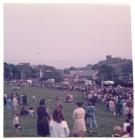Content can be downloaded for non-commercial purposes, such as for personal use or in educational resources.
For commercial purposes please contact the copyright holder directly.
Read more about the The Creative Archive Licence.
Description
Criccieth The Fairs.
Edward Ist granted the town a charter in the 13th century and an important day for the borough was during October at Michaelmas when the two bailiffs were elected. There was a fair on this day which, is said, was the biggest in North West Wales. April 25th (St Marks Day) was also a fair day. Other important fairs were during May (The May Fair), end of June (Midsummer Fair, St Johns Fair or Ffair Wyl Ifan) and during November (All Saints /Calan Gaeaf). Weekly markets were held beneath the castle down to the seashore at Abermarchnad. Here, small ships beached to unload coal, limestone and grain. At nearby Pencei fishing boats brought in their catches of herring and mackerel. At that time the main road, or Turnpike, had not been built through the area and the centre of the town was at the foot of the castle on either side of the hill. In those days the Green - Maes Glas as it was called, extended from the northern border of the parish down either side of the track to the shore. It was much more extensive than it is today. Here is where the horse and cattle fairs were held. There is not much documentation regarding the fairs until the 18th century. Around 1807 the Turnpike was laid through the district and the centre of the town moved from the castle and developed along the new main road. The fairs and markets were held here as they are to this day. The weekly fair had been discontinued in 1787 but the four remaining were important and very well attended. Farmers, drovers, shepherds and dealers came from far afield. The main horse and cattle fair was in May though livestock was sold and bought at every fair. The Midsummer / Wyl Ifan Fair on June 29th June was when the farm hands came in their hundreds to be hired for the hay harvest. The taverns and inns were busy and often it became unruly and many had to be put in the lockup for the night. Farm tools and implements were also sold then and hawkers sold their wares. Of course there were tinkers, fortune tellers and gypsies selling their good luck charms. In the 1851 census there were two men, from the well known Abram Wood family, lodging in the town. One is recorded as a fiddler, the other a Tinman (tinker).
The coming of the railway in 1867 brought even more livestock to and from the town and bedding from Manchester, carpets from other parts and crockery from the Stafford Potteries for the ladies running the lodging houses to accommodate the growing numbers of tourists. The bargaining was great fun to watch as was the calling and sales tricks from the traders. From Victorian times with the markets and livestock sales came the funfair. At first this was held further along the Main Road so the length of the street was bustling with activity and people and children enjoying themselves. The last horse sold at the fair was in 1949 so ending a long tradition. There are fewer stalls on the Maes today but the funfair still arrives on 23rd May and 29th June.






Do you have information to add to this item? Please leave a comment
Comments (0)
You must be logged in to leave a comment